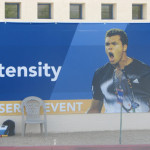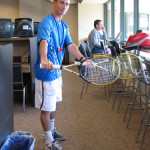Finally some concrete info on the Roddick-Connors split, and our suggestions for Sania Mirza’s wrist problem.
Dish on the Roddick-Connors Split
It turns out that one of the journalist hanging at the Media Center here at Indian Wells has some dish on the Andy Roddick–Jimmy Connors breakup. His name is Doug Robson and he’s the lead tennis writer for USA Today.
As you can see here on his aptly named blog, Doug’s Sports Dish, Andy wanted to swing by New York on his way to next week’s tournament in Miami and spend some time with his girlfriend, Sports Illustrated swimsuit model Brooklyn Decker. Not sure about that name, for some reason it reminds me of baseball cards or the upper deck of Yankee Stadium.
Anyway, Andy wanted Jimmy to fly to New York and get in a few training sessions but Jimmy didn’t want to travel, he wanted to stay home in Santa Barbara. This led to a showdown and, finally, a long conversation in which they decided to end their working relationship. Thanks to Doug for that, a little bit of info goes a long way to understanding a situation.
Sania and the Quick Fix
Sania Mirza has to decide whether to change her extreme western grip or have surgery because she has recurring soreness in her wrist. This is what she said after playing with wrist pain in a loss to Daniela Hantuchova earlier this week:
It’s a big step to even change it half an inch because my game is my forehand. You know, it’s not easy to change a grip at the stage where you’re, like, 30 in the world. I would obviously like to look at other options before that.
It sounds like she’d prefer surgery to changing her grip. This is a common attitude and it’s one of the reasons you see so many people with elbow straps and knee straps on tennis courts – it’s easier to get a medical procedure than change a grip. Here are the typical options for an injury:
1. Take aspirin or some other anti-inflammatory. I play tennis with a woman who takes aspirin before she goes out to play.
2. Get a chiropractic adjustment, acupuncture, or some other kind of bodywork to relieve the symptom.
3. Surgery.
Here’s the problem: if you take an anti-inflammatory or get a chiropractic adjustment then go out on the court and swing the racket exactly the same way, the soreness and inflammation will return. How could it not, nothing has changed. Surgery will bring you relief if the injury was a one-time accident – say you stepped wrong and twisted your knee – but it’ll only relieve the problem temporarily if you have a chronic problem resulting from your swing or some other repetitive movement.
Mirza is choosing temporary relief and it could work if the relief lasts as long as her tennis career, but it’s possible she’ll need surgery again. Tommy Haas had his third shoulder surgery last November, for instance. Mirza is between a rock and hard place because her forehand is the shot that sets her apart. If she changes her grip her forehand may be less effective, but there might be an alternative.
I am not a medical expert of any kind but I did stay at a Holiday Inn last night…uh, uh, I meant to say that recently I moved into a house with stairs after living in a one story house for a few years and my knee started bothering me. I went to an Alexander Technique instructor who showed me that I was turning my foot inward when I walked downstairs. Now I’ve successfully changed my movement habit and my knee doesn’t hurt.
I don’t know if Mirza could benefit from this kind of work because she’s been using that grip for 16 years and it would be hard for her to take a long break from the tour, but I see it all the time: athletes at all levels choose cortisone shots and surgery without addressing the basic problem. This is, in no small part, due to our medical system. Insurance pays for quick fixes but it doesn’t pay for long term work that will relieve the problem permanently.
Insurance will pay for physical therapy but physical therapists are not swing coaches and swing coaches are not necessarily the answer either.
After swinging the racket the same way for so long, Mirza might have deeper structural problems than just her grip. Maybe she compresses her body on one side or lifts her shoulder and constricts nerves in the area, I don’t know, but I dearly wish our health system embraced bodywork that teaches us to change our movement habits rather than offering up quick, and temporary, fixes. Most athletes would be much better off.


